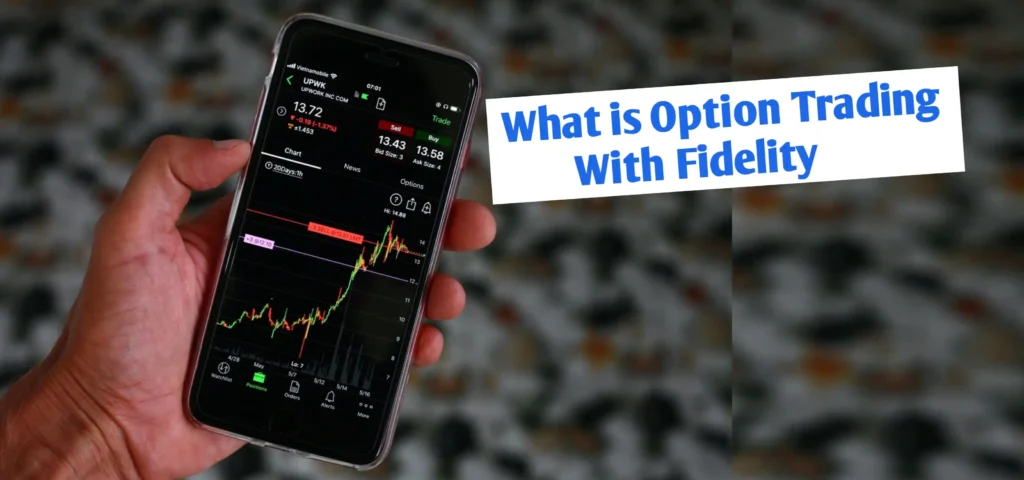It may not be new to you that you can buy shares in the share market and earn money. But do you know that it is possible to earn money even without buying a full share in this market? I think this can be a new thing for most of you.

And everyone likes interesting things like making money. So this method of trading is called option trading. About which it is often heard that you can earn a lot of money in a very short time in this trading.
So in such a case, it is necessary to know about this trading. That’s why we have write this article today so that you can know what is option trading? How is it different from stock trading? What are its benefits and risks? How many types are there? And much more.
So stay with us till the end of the Arton your quick support channel. So let’s start and know about option trading in a little detail. In which we first know what is option trading with fidelity?
So this is a type of financial contract that gives you the right to buy or sell shares in the future. Option trading is a part of the stock market. And this is a type of derivative trading.
This means that in order to understand the option, it is necessary to understand the derivative trading first. So see, derivative trading is in both the stock market and the commodity market. I told you that gold, oil, and agricultural products come in the commodity.
And in stocks, shares, bonds, mutual funds, and derivatives, etc. come. Where you buy a share of the company in stock trading, In derivative trading, you put a price on anything, i.e. the price of the underlying asset.
The special thing about this is that you do not have that thing. In this type of trading, the price of something increases or decreases, and a price is set on it. This thing can be shares, gold, oil, or something else. And they are called underlying assets. You can earn money on its price without buying it.
And you can also lose it. This is derivative trading. There are mainly two types of derivatives, futures and options. And in addition to these, there are also forwards and swaps in other derivatives. So after understanding the basic concept of derivative trading, Now let’s focus on its one type, i.e. option trading. And we know how this trading is different from stock trading.
So buying a stock is like opening your own shop. You become its owner and the entire profit and loss of the shop is yours. While buying an option is like buying the right to buy goods in the shop. You do not become the owner.
You just buy the right that you can buy or sell goods in the future. And it is not necessary to do this. That is, if you want to buy or sell goods in the future, then do this.
Otherwise, there will be no pressure or restriction on you. In this derivative trading type, you have an alternative, i.e. option, that what you will do. That’s why this type of trading is called option trading.
Options are mainly of two types, call option and put option. Call option is the contract in which you get the right to buy a share for a fixed date at a fixed price in the future. But it is not necessary to buy .
This fixed date is called expiry date and fixed price is called strike price. You give a small amount, i.e. premium, to buy this right. This premium depends on many factors, such as the current price of the share, the strike price, the expiry date, etc.
If the price of the share exceeds the strike price before the expiry, then the call option becomes valuable. In this case, you can earn money by using this right. Let’s understand this with this example.
Suppose the share of the company is Rs. 2000. Now you think that it will go up to Rs- 2200. So you buy a call option whose expiry is after a month and the strike price is Rs- 2100.
You have given a premium of Rs. 50 for it. Now if the share of that company becomes Rs- 2200, then the price of your option will increase. You can earn a good profit by selling it.
But if the share of that company becomes Rs- 1800, then the price of your option will become zero and you will incur a loss of Rs- 50. In this way, you can get both profit and loss from the call option.
And now let’s talk about the put option. The put option is a kind of contract in which you get this right that you can sell something like a share at a fixed price and a fixed date. But doing this is not compulsory.
You give a small amount for this right, i.e. a premium. After that, if the price of that thing decreases, then you can earn money by using this right. In the put option, the strike price is the price at which you can sell a share in the future.
To understand this better, let’s look at this example. Assume that you have invested in a share or such an asset and you are afraid that its price may decrease. So you can limit your loss by buying the put option.
For this, you can buy a put option of Rs. 100 strike price. And this means that after a month you are buying the right to sell that share at Rs- 100 per share. No matter what the price of the share is at that time. For this, you have also given a premium of Rs- 5 per share.
Now if after a month the price of the share becomes Rs-80, then you can use your put option to sell the share for Rs- 100. This will give you a profit of Rs. 20 per share.
But if after a month the price of the share becomes Rs. 120, then you will not use your put option. Because you can easily sell the share for Rs- 120 in the market. In this situation, your put option will be useless and you will not get back the Rs. 5 premium you gave.
So in this way, the call option gives you the right to buy shares and the right to sell the put option. If you think that the price of something will increase, then use the call option. And if you think that the price of something will decrease, then use the put option.
In addition to these two types of option trading, there are many types of strategies in option trading. These strategies are based on your guess about the market. For example, if you think that a share will increase, then you will adopt one type of strategy.
And if you think that the share will decrease, then you will adopt another type of strategy. These strategies are bullish option strategy, bearish option strategy, and neutral option strategy. Bullish option strategy means that you are assuming that the price of the share will increase.
On this basis, you buy or sell some options. Bearish option strategy means that you are assuming that the price of the share will decrease. On this basis, you buy or sell some options.
And a neutral option strategy means that you believe that the price of the share will not rise too much and will not fall too much, i.e. the price will remain almost stable. You buy or sell some options on this basis. It is possible to use the right strategy at the right time on the basis of experience, knowledge and risk.
But where is option trading done? So in India, you can do it on stock exchanges such as National Stock Exchange NSE and Bombay Stock Exchange BSE. And an adult Indian citizen who has a valid PAN card and Aadhaar card can open his Demat or trading account and start option trading. Many platforms are available for option trading.
Brokerage firms offer these platforms and this platform facilitates you to buy, sell and manage your portfolio. Zerodha, Upstox, Angel One, Five Paisa and Grow are some such popular brokerage firms. And while choosing the best suitable brokerage firm platform for you, the platform’s user friendliness, brokerage charge, customer support, trading tools and features should be kept in mind.
For this, you can first go to the website of these brokerage firms and learn about their services and charges in detail. You can compare them and then choose the right platform for yourself. By the way, it is also very important to know that there is a very high risk in option trading.
A very large amount cannot be invested in it just because of basic knowledge. So it is better to go into detail about option trading first and understand how its strategies should be applied and take advice from a financial advisor before making a big investment. And in the beginning, only 5-10% of your total money should be invested in option trading.
Because if your guess is right, you can earn a lot of money very quickly. But if your guess is wrong, you can also get into a lot of loss in a jiffy. So, option trading is also more complex in comparison to shares, so it may take a little more time to understand it.
So, in this case, avoid haste and get into this trading carefully with proper knowledge. And with this, this video, which gives you basic information about option trading, comes to an end here. How did you like this video? Do tell us in the comment section.
If you have already liked it, then it is necessary to share it. If you liked it, subscribe to the Supports so that you can get notifications all the time. Keep sending us your questions.
FAQ
What is Trading?
Trading is the act of buying and selling financial instruments, like stocks, currencies, or commodities, with the goal of making a profit from price fluctuations within a specific timeframe. It is the fundamental law of every economic system. Any country’s growth capacity depends on the trade taking place in it. All kinds of commercial transactions occur in markets, including the stock exchanges for share trading.
What is Option Trading?
Option trading is a type of financial trading that allows buyers to purchase the right, but not the obligation, to buy or sell an underlying asset at a predetermined price and date. Options trading differs from other financial instruments in several ways.
Advantages of Options Trading?
i) making it a more cost-effective approach for traders.
ii) Options can enhance an investment portfolio by offering additional income, leverage, and protective strategies against market declines.
iii) Options serve as a potent tool for hedging risk.
iv) power, effectiveness. trying to gain more political leverage.
Disadvantages of option trading
i) this are complicated
ii) Before you can trade options, you need to receive approval from your brokerage firm.
iii) Loss potential is high for sellers
iv) Many individual stock options don’t have much volume at all.

